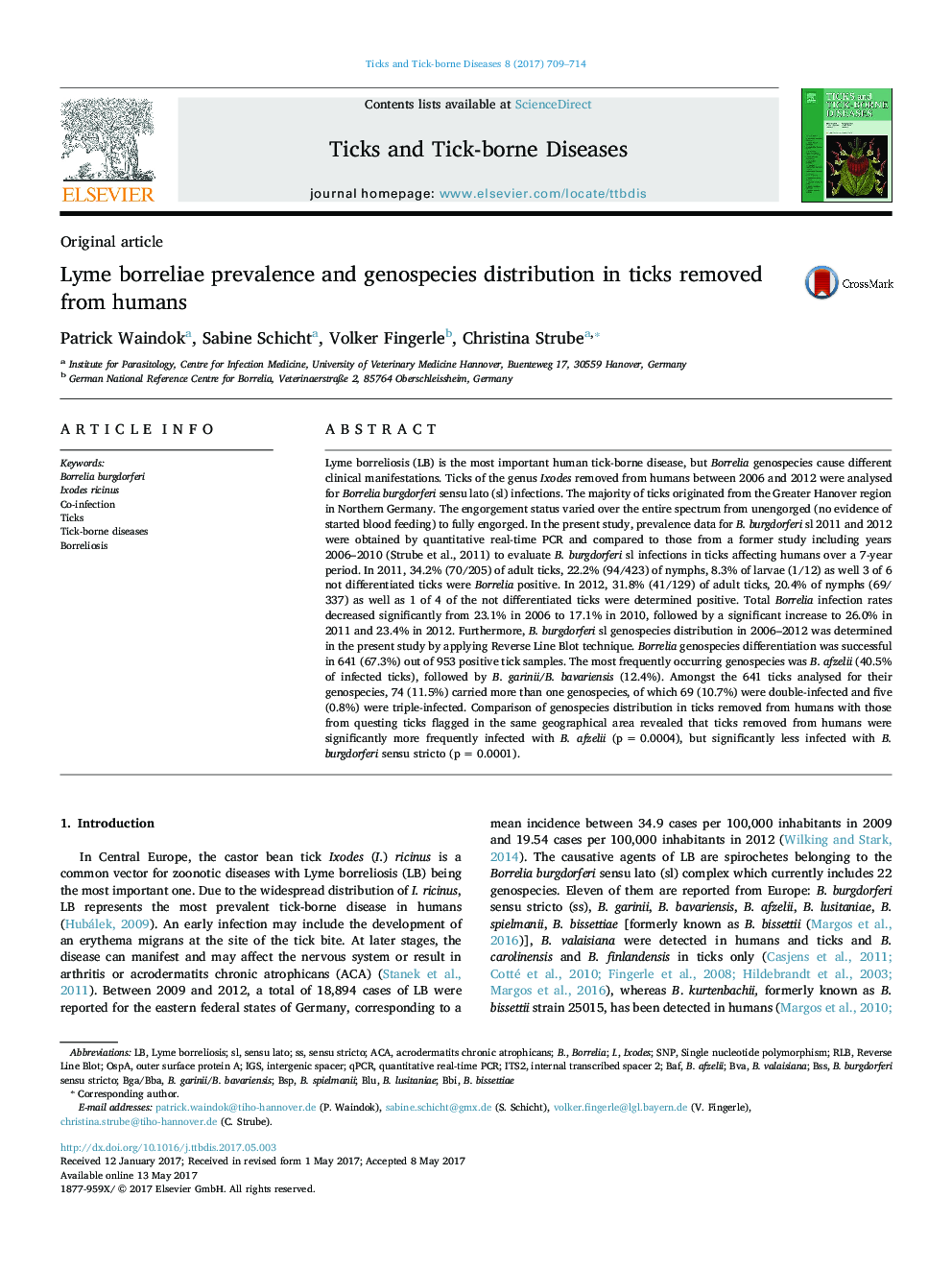| کد مقاله | کد نشریه | سال انتشار | مقاله انگلیسی | نسخه تمام متن |
|---|---|---|---|---|
| 5546328 | 1402740 | 2017 | 6 صفحه PDF | دانلود رایگان |
عنوان انگلیسی مقاله ISI
Lyme borreliae prevalence and genospecies distribution in ticks removed from humans
دانلود مقاله + سفارش ترجمه
دانلود مقاله ISI انگلیسی
رایگان برای ایرانیان
کلمات کلیدی
OspARLBBBIIxodesBVABSSITS2BSPBAFIGSACAqPCRblu - بلوزBorrelia - بورلیاBorrelia burgdorferi - بورلیا بورگدورفریBorreliosis - بورلیوزیسLyme borreliosis - بورلیوس لایمTick-borne diseases - بیماری های منتقله از راه خونInternal transcribed spacer 2 - داخلی رونویسی spacer 2Co-infection - عفونت مشترکintergenic spacer - فضاپیمای بینابینیReverse line blot - معکوس خط بلوتوثquantitative real-time PCR - واکنش زنجیره ای پلیمراز واقعی در زمان واقعیOuter surface protein A - پروتئین سطح خارجی ASingle nucleotide polymorphism - پلیمورفیسم تک نوکلئوتیدیSNP - چندریختی تک-نوکلئوتیدTicks - کثافتIxodes ricinus - کنه های کرچک
موضوعات مرتبط
علوم زیستی و بیوفناوری
علوم کشاورزی و بیولوژیک
علوم دامی و جانورشناسی
پیش نمایش صفحه اول مقاله

چکیده انگلیسی
Lyme borreliosis (LB) is the most important human tick-borne disease, but Borrelia genospecies cause different clinical manifestations. Ticks of the genus Ixodes removed from humans between 2006 and 2012 were analysed for Borrelia burgdorferi sensu lato (sl) infections. The majority of ticks originated from the Greater Hanover region in Northern Germany. The engorgement status varied over the entire spectrum from unengorged (no evidence of started blood feeding) to fully engorged. In the present study, prevalence data for B. burgdorferi sl 2011 and 2012 were obtained by quantitative real-time PCR and compared to those from a former study including years 2006-2010 (Strube et al., 2011) to evaluate B. burgdorferi sl infections in ticks affecting humans over a 7-year period. In 2011, 34.2% (70/205) of adult ticks, 22.2% (94/423) of nymphs, 8.3% of larvae (1/12) as well 3 of 6 not differentiated ticks were Borrelia positive. In 2012, 31.8% (41/129) of adult ticks, 20.4% of nymphs (69/337) as well as 1 of 4 of the not differentiated ticks were determined positive. Total Borrelia infection rates decreased significantly from 23.1% in 2006 to 17.1% in 2010, followed by a significant increase to 26.0% in 2011 and 23.4% in 2012. Furthermore, B. burgdorferi sl genospecies distribution in 2006-2012 was determined in the present study by applying Reverse Line Blot technique. Borrelia genospecies differentiation was successful in 641 (67.3%) out of 953 positive tick samples. The most frequently occurring genospecies was B. afzelii (40.5% of infected ticks), followed by B. garinii/B. bavariensis (12.4%). Amongst the 641 ticks analysed for their genospecies, 74 (11.5%) carried more than one genospecies, of which 69 (10.7%) were double-infected and five (0.8%) were triple-infected. Comparison of genospecies distribution in ticks removed from humans with those from questing ticks flagged in the same geographical area revealed that ticks removed from humans were significantly more frequently infected with B. afzelii (p = 0.0004), but significantly less infected with B. burgdorferi sensu stricto (p = 0.0001).
ناشر
Database: Elsevier - ScienceDirect (ساینس دایرکت)
Journal: Ticks and Tick-borne Diseases - Volume 8, Issue 5, August 2017, Pages 709-714
Journal: Ticks and Tick-borne Diseases - Volume 8, Issue 5, August 2017, Pages 709-714
نویسندگان
Patrick Waindok, Sabine Schicht, Volker Fingerle, Christina Strube,